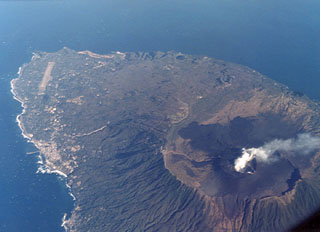Report on Izu-Oshima (Japan) — April 1987
Scientific Event Alert Network Bulletin, vol. 12, no. 4 (April 1987)
Managing Editor: Lindsay McClelland.
Izu-Oshima (Japan) Steam emission; tremor and strain changes; earthquake swarms
Please cite this report as:
Global Volcanism Program, 1987. Report on Izu-Oshima (Japan) (McClelland, L., ed.). Scientific Event Alert Network Bulletin, 12:4. Smithsonian Institution. https://doi.org/10.5479/si.GVP.SEAN198704-284010
Izu-Oshima
Japan
34.724°N, 139.394°E; summit elev. 746 m
All times are local (unless otherwise noted)
Since the 18 December explosion, no additional eruptive activity has been reported. Steam jets rose daily to 10 m above some of the November fissures and white clouds usually extended 50 m above the summit.
Seismicity declined steadily after the November eruptive event and continued to decline through March. There was no change in the distribution of epicenters, which were concentrated in a zone trending NNW-SSE on the island. Volcanic tremor resumed on 1 January, after 10 days of quiet, occurring at almost regular 1-hour intervals (figure 6) [but see 12:1]. Periodic tremor had declined by February but continued at [January] amplitudes. Durations of tremor episodes ranged from 10 to 30 minutes. The tremor source (estimated from amplitude at each seismometer) appeared to be below the central cone (Mihara-yama).
Periodic tremor was accompanied by step-like strain changes, recorded by a borehole strainmeter 108 m below sea level, 5 km N of Mihara-yama. Step-like expansion began on 1 January, reversing to contraction on 22 January [see also 12:1]. Other strainmeters had shown gradual contraction since the 21 November eruptive activity, before strain virtually ceased.
UPI reported that earthquake swarms began 6 May off the NW coast of the island, 10-20 km below the ocean floor. Of the 1,571 total recorded earthquakes 6-12 May [but see 12:6], 895 occurred on the 11th, the day of the largest event (M 5.1).
Geological Summary. Izu-Oshima volcano in Sagami Bay, east of the Izu Peninsula, is the northernmost of the Izu Islands. The broad, low stratovolcano forms an 11 x 13 km island constructed over the remnants of three older dissected stratovolcanoes. It is capped by a 4-km-wide caldera with a central cone, Miharayama, that has been the site of numerous recorded eruptions datining back to the 7th century CE. More than 40 cones are located within the caldera and along two parallel rift zones trending NNW-SSE. Although it is a dominantly basaltic volcano, strong explosive activity has occurred at intervals of 100-150 years throughout the past few thousand years. A major eruption in 1986 produced spectacular lava fountains up to 1,600 m high and a 16-km-high eruption column; more than 12,000 people were evacuated from the island.
Information Contacts: JMA; UPI.


